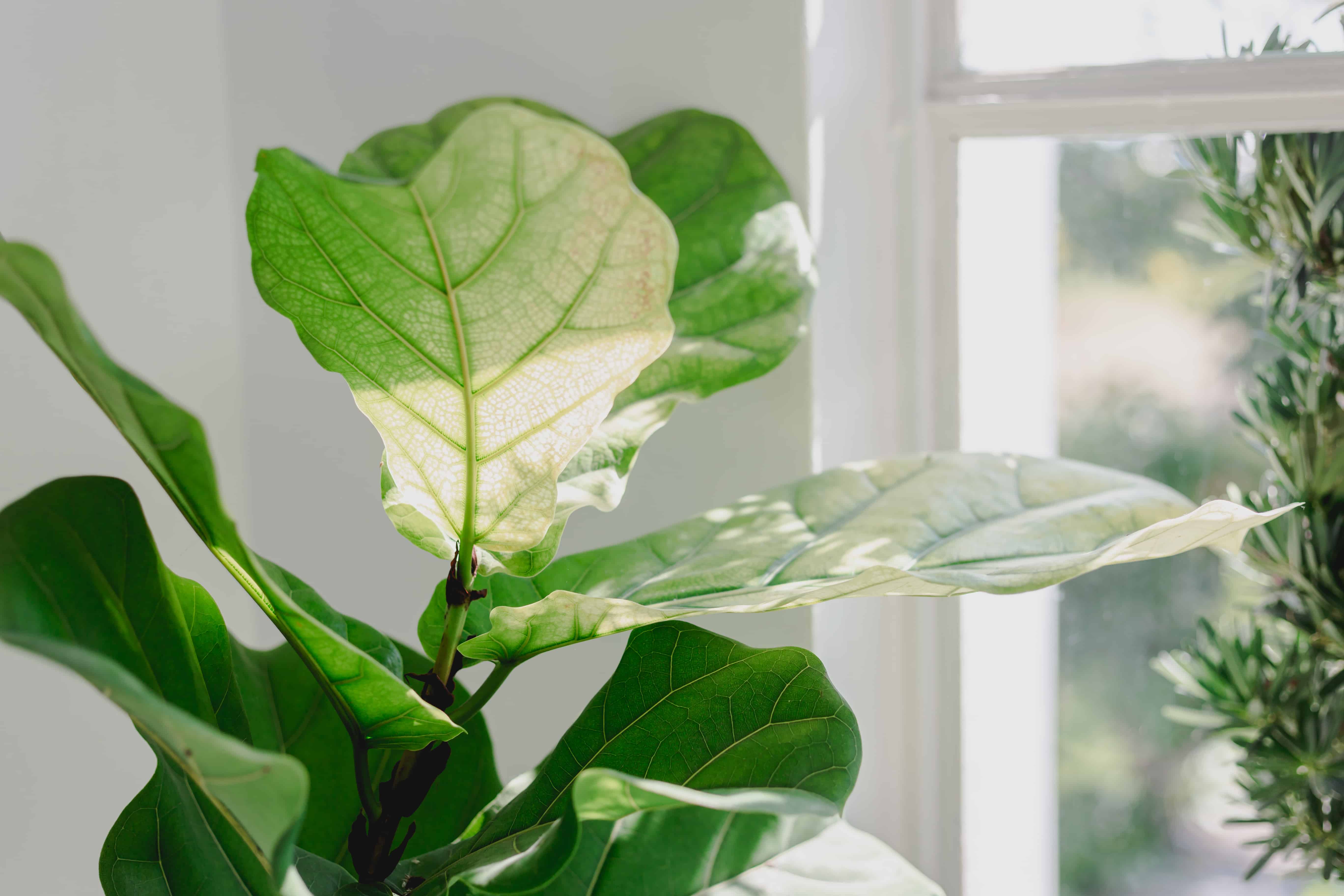Fiddle leaf figs (Ficus lyrata) are one of the most popular houseplants. They’re relatively easy to care for and are attractive in any space. The first step to growing a thriving plant is adequate soil. After all, soil is the basis for almost all nutrient and water absorption!
Here, you’ll find some of the best soil mixes you can buy for your fiddle leaf fig, along with a recipe for making your own. As a bonus, we include tips on how to keep your tree thriving beyond the nursery.
1. Soil is the Basis for a Healthy Plant

Fiddle leaf figs and their other
Ficusrelatives are popular houseplants.
©Rachata Teyparsit/Shutterstock.com
Starting with the right soil gives your plant the best chance of thriving in the long term. Fiddle leaf fig soil should have superb aeration, while also having enough moisture-retaining qualities. It should be between 6 and 7 on the pH scale for optimum nutrient absorption.
Best Pre-Made Soil Mixes for Fiddle Leaf Fig
The best pre-made soil you can buy is one that is tailored for fiddle leaf figs. The Fiddle Leaf Fig Resource’s blend is the best soil you can hope to have for your plant short of making it yourself. It contains the perfect blend of organic materials, aeration, and moisture-controlling materials. The downside to this blend is it is relatively expensive. If you have a large plant or multiple fiddle leaf figs that need repotting, it can add up quickly.
Another worthy soil mix is Perfect Plant’s fiddle leaf fig soil mix. Like the other soil blend, it’s made with fiddle leaf figs in mind. This is a bit more of a cost-effective option and boasts the same qualities that make the Fiddle Leaf Fig Resource blend great. It is also in the right pH range for a fiddle leaf fig.
Avoid choosing a regular potting mix from Miracle-Gro, such as their all-purpose soil or tropical plant soil. These can be used as a base but require additional components to make it effective. These soils are too dense and will not allow for proper aeration or drainage, leading to rot in the plant.
DIY Fiddle Leaf Fig Soil Recipe
Making your own batch of fiddle leaf fig soil is probably much easier than you think. It can also be a more cost-effective method, especially if you have other plants with similar soil requirements. You’ll need the following components:
- Coconut coir
- Orchid bark or pine bark fines
- Coarse sand or perlite
- Compost
- Activated charcoal or char
- Soil
- Measuring cup
Mix equal parts compost, soil, coconut coir, and bark together. Add to half part activated charcoal or char. Mix thoroughly in a large container, preferably with a well-sealing lid so you can store the excess. Remove what you need to pot your plant and save the rest for next year’s repot!
2. Find the Right Light
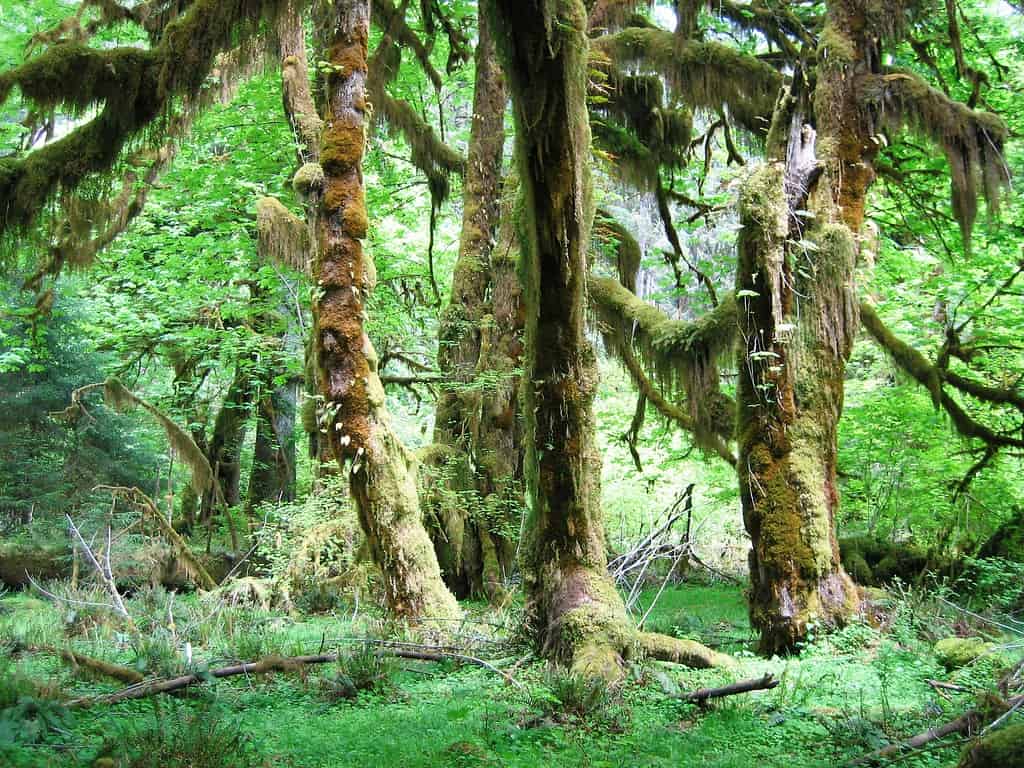
Plants living underneath tall trees have adapted to shade but can still handle some direct light.
Having the correct light is imperative to your plant’s survival. Bright, indirect light is ideal for a fiddle leaf fig, as they natively grow in rainforests, often covered by many taller trees. Some direct light is good, especially for variegated varieties.
A good place to situate your fiddle leaf fig is in an area that gets south-facing light or even west-facing light with a bit of a filter. East-facing light is likely not enough to power vigorous growth during the growing season. If your plant is getting south or west-facing exposure, be sure it has access to a bit of shade. If outdoors, a building or a large tree can provide adequate shade. Indoors, a thin curtain will prevent leaves from burning.
3. Water Correctly
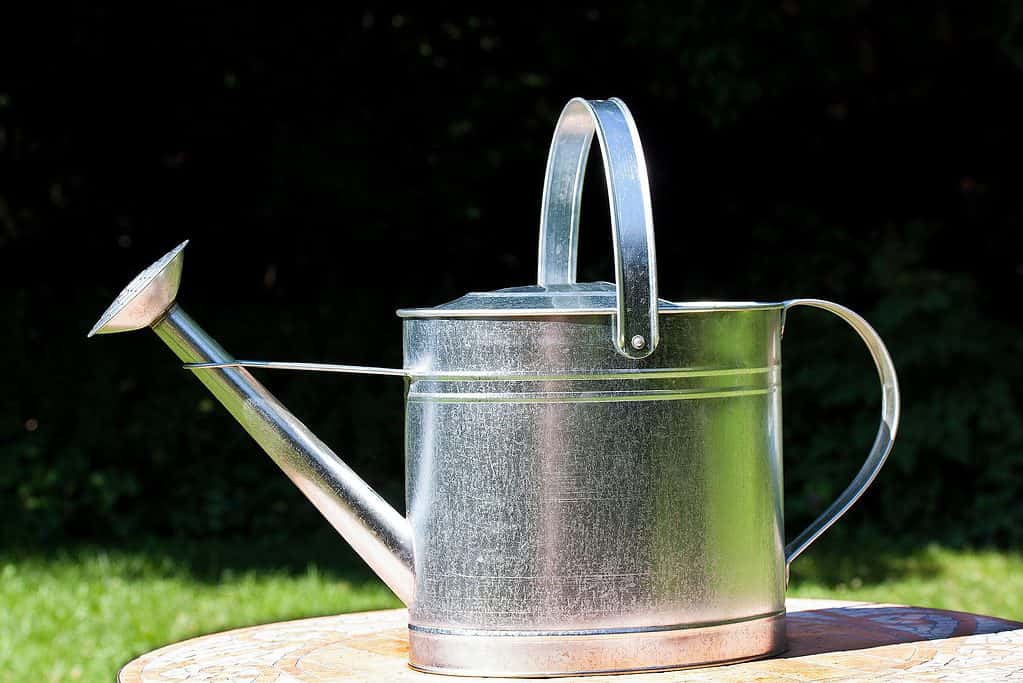
Fiddle leaf figs are best watered with distilled water or rainwater.
©
Part of the beauty of choosing the best soil mix for fiddle leaf figs is the built-in moisture protection elements like coconut coir and compost. Thanks to their rainforest roots, fiddle leaf figs tolerate a period of dryness well. You are better off waiting a bit longer than you think to water your plant than giving it a few sips of water each day.
Water deeply once the soil has dried most of the way through the pot, if not completely. You can test the soil moisture using a moisture meter or a wooden skewer inserted deep into the pot. Upon removal, it should be clean. This is how you’ll know your plant is ready for a drink. For smaller specimens, you can lift the pot to gauge its weight relative to how wet or dry the soil is. However, this method might not work as your plant gets larger and heavier!
When watering, be sure you’re giving enough so the excess water can drain out the drainage holes in the pot. Don’t let your plant sit in standing water; if you’ve got a saucer beneath it to catch the drained water, be sure to empty it. Watering evenly over the soil and providing deep drinks instead of frequent, shallow sips will help the root system grow strong. A robust root system will be able to grow bigger, healthier leaves and support more of them, too!
4. Maintain a Constant Temperature

Avoid too many temperature fluctuations to minimize the stress in your fiddle leaf fig.
©Olivier Le Moal/Shutterstock.com
Avoid shocking your plant with shifts in temperatures or conditions. Drafts from windows, doors, or air conditioning vents can stress it out and might even cause leaves to drop. Between 60-80°F is the ideal growing temperature for these plants. If you live in areas where it gets cold outside, it’s best to grow the plants indoors year-round. Alternatively, you can keep them in pots so you can move the plant back indoors when temperatures drop.
5. Humidity Aids in New Growth and Retaining Old Growth
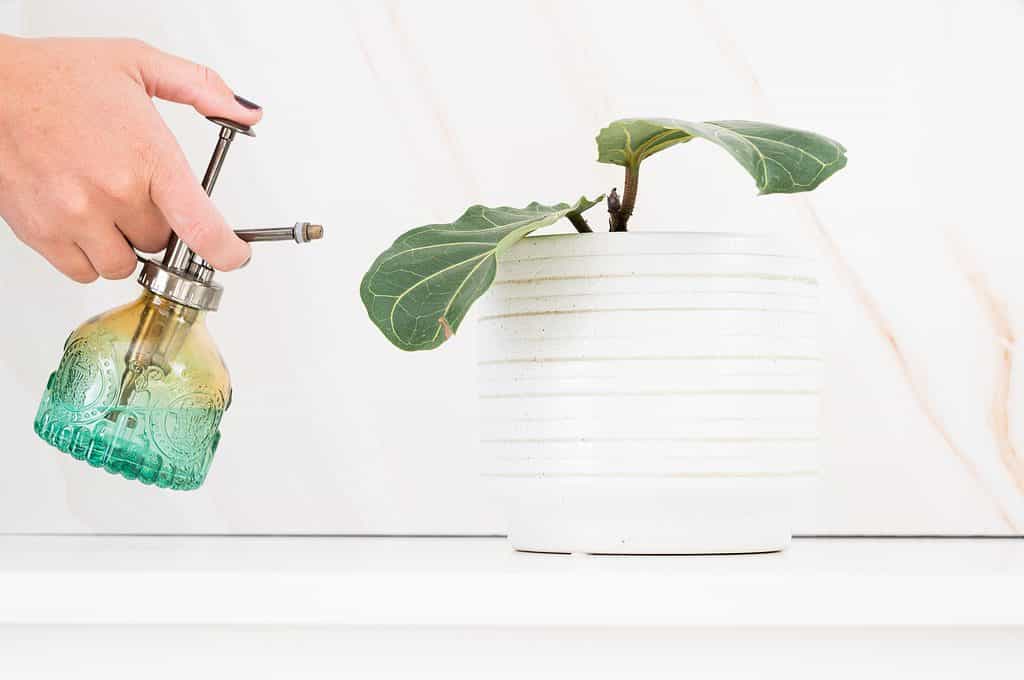
Humidity is easily overlooked. A lack of moisture in the air can lead to drying and drooping leaves.
©Cavan-Images/Shutterstock.com
Prime levels of humidity for a fiddle leaf fig are above 50%, preferably around 65%. Humidity helps plants reduce water loss and encourages more growth. You can add a humidifier near your plant to achieve this level of humidity. Misting regularly can also increase levels of humidity, though the results are much shorter-lived and harder to measure. Regardless, it might be helpful to have a humidity gauge or hygrometer nearby to monitor this parameter.
6. Pruning: Out with the Old, In with the New!

Sterilize tools between use and plants to avoid accidentally spreading pests or diseases.
©ueuaphoto/Shutterstock.com
When you prune a fiddle leaf fig, you’re doing so to propagate it, control or shape its growth, or simply to manage old, ugly, or diseased leaves. It’s important to use sterile, sharp scissors or shears. Cut at a 45° angle just above a node.
Pruning to Propagate
Pruning for propagation requires you to remove a node for a cutting that will root. For the best chances of survival, you’ll want to choose a healthy segment of your plant that has at least three to five leaves. Remove the leaf closest to the cut. Dip the cut side in rooting hormone if you’d like to increase your cutting’s chances of survival.
Your cutting can then be put in water or soil for a few weeks to a few months to start growing roots. If you propagate in water, choose a clear container and change the water every few days to a week. Once you see roots begin to appear, you can move to soil. Be sure you water the transplant well to make its move from water to soil as smooth as possible.
Pruning for Growth
You can also prune to control its growth or overall growth habit. If you prefer your fiddle leaf fig to be tall and slender, but it’s getting a bit too tall for your liking, you can lop off the top. However, this will cause the new growth to emerge forked. This might not be the look you’re going for. To avoid this, consider trimming the roots instead of repotting your plant into a larger pot. By doing this you’re constricting the roots to a certain size, which will limit how much foliage growth the plant can put out.
Alternatively, you might like the look of a bushier plant. If so, then you might consider pruning your plant while it’s still small to encourage more branching growth rather than a strictly vertical growth pattern.
Pruning for Clean-Up
It’s natural for older leaves to yellow and become unsightly when they’re near the end of their lives. You can always let them shrivel and fall off the plant naturally, or you can remove them yourself through pruning. Remove diseased leaves as soon as you notice them. This will help prevent the issue from spreading to other parts of your plant, and also keep it looking nice and manicured.
7. Repot Yearly
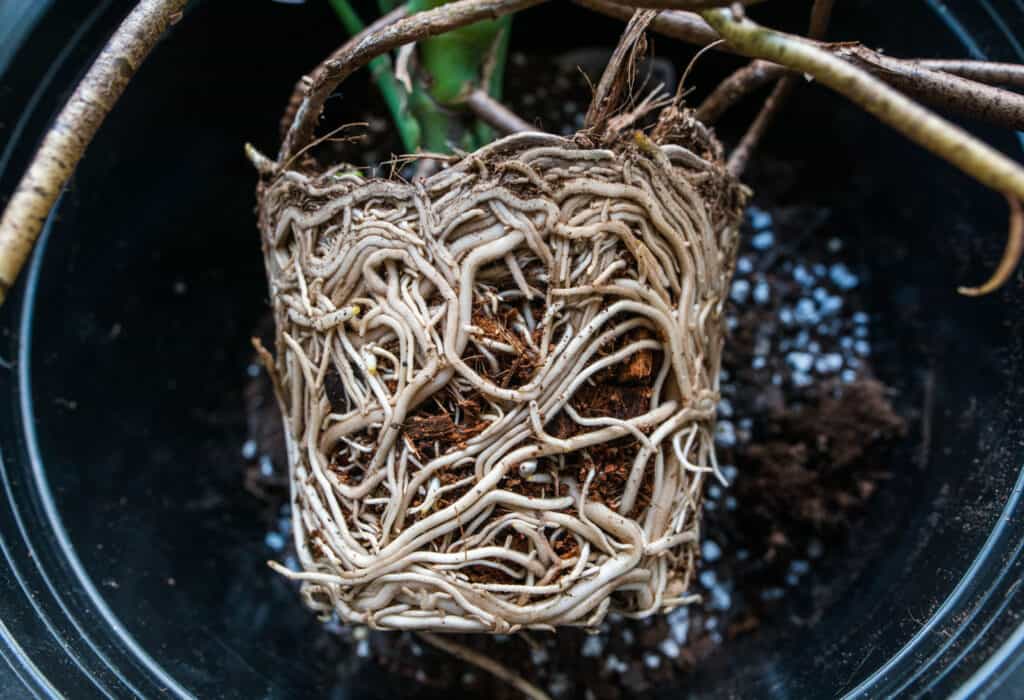
Taking too long between repotting can lead to a rootbound plant, which might see stunted growth.
©Jones M/Shutterstock.com
Fiddles grow at a decent pace, so if you want to encourage growth, it’s best to repot your plant regularly. On average, a fiddle leaf fig benefits from repotting yearly in ideal conditions.
When repotting you should change out the soil and inspect the roots while the plant is out of the pot. It’s best to remove as much soil from the roots as possible so you can thoroughly check for any signs of rot or damage. Healthy roots are light in color and firm, so if you see any roots that are slimy, soft, or dark, remove these with sharp, sterile tools.
If you want your plant to continue growing, choose a pot one to two sizes larger. This gives the roots room to continue to expand, which will help support more foliage development. You can also choose to trim the roots and just change out the soil, leaving your plant in the same size pot to keep it the same size.
8. Fertilize During the Growing Season

Liquid fertilizer is used for fiddle leaf figs, though time-released fertilizer can also be employed.
©A-Z-Animals.com/Larissa Smith
Since fiddle leaf figs are prized for their foliage and not their flowers or fruits, you will want a fertilizer with more nitrogen than any other nutrient. The 3-1-2 fertilizers are the best because they have a higher proportion of nitrogen to support plenty of foliage growth. Fertilizers can easily be abused if used too frequently or at too high of a dose. When this happens, foliage can become “burnt” along the edges of the leaves, which is the opposite of what you want!
Be sure to follow the dosage instructions carefully as suggested on the product. These aren’t heavy feeders. Fertilizing once a month throughout spring and summer is sufficient. If you’d like, you can fertilize once in the fall and once in the winter, too.
9. Wipe Those Leaves
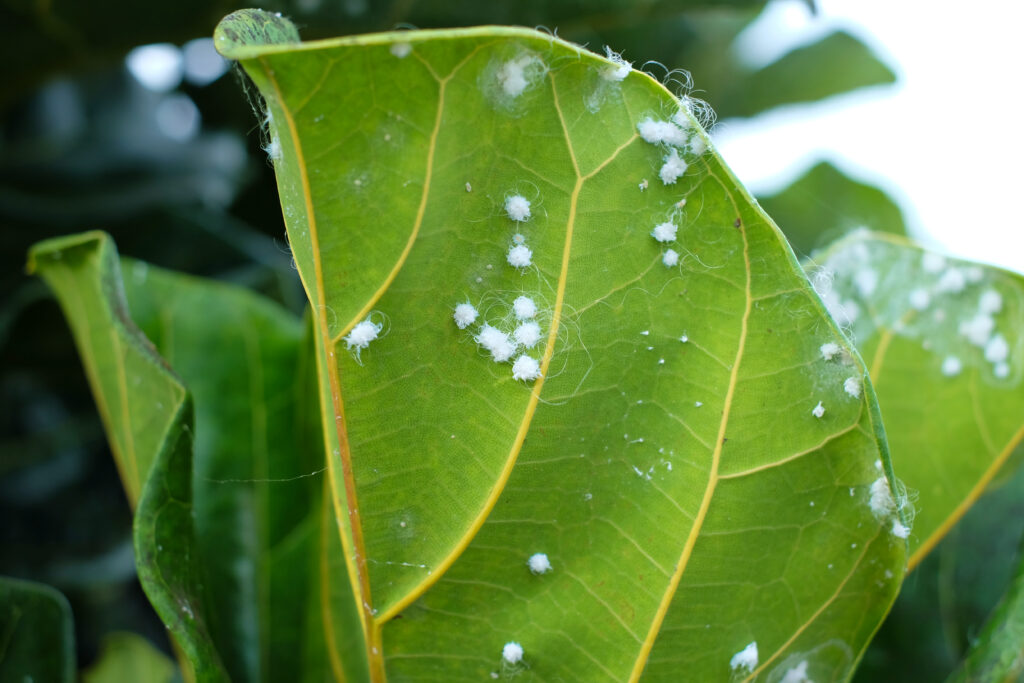
When you wipe off the leaves you can also monitor for any pests or issues.
©daguimagery/Shutterstock.com
The finishing touch in caring for your fiddle leaf fig is wiping off its lovely broad leaves. This benefits the plant by removing any dust that accumulates on the leaves, which can eventually hinder how much light is able to be processed into energy. Additionally, this helps make the plant look its best.
Wipe the leaves off using a damp, soft cloth. Be sure to support the bottom of the leaves when you are cleaning them to avoid accidentally breaking off stems or tearing foliage.
Final Thoughts
Having a clear understanding of what makes plants thrive can make taking care of a beautiful plant less intimidating. Following the tips in this guide will help you stay mindful and instruct you on how to optimize the environment to best suit a universally loved tropical houseplant.
Thank you for reading! Have some feedback for us? Contact the AZ Animals editorial team.

